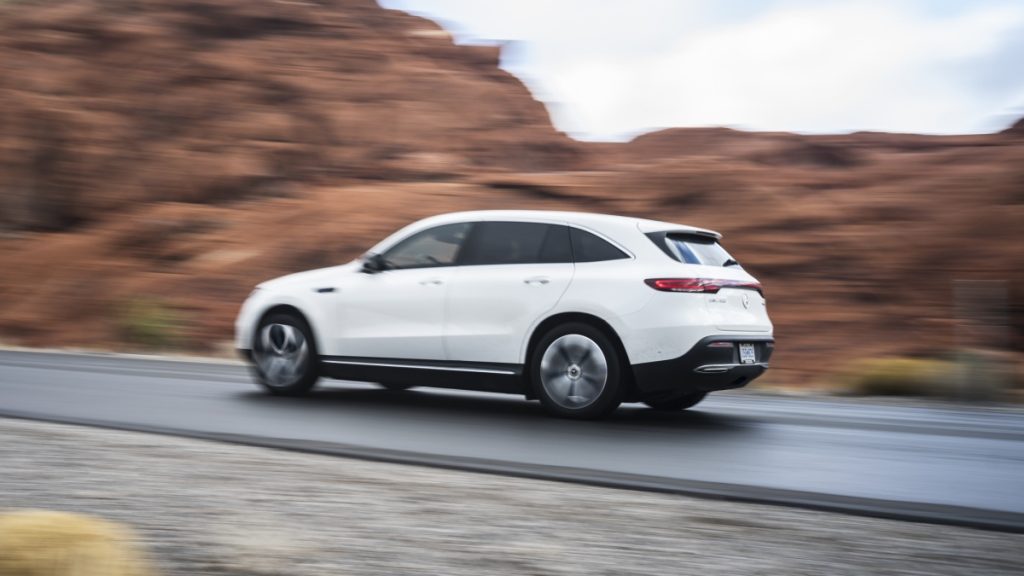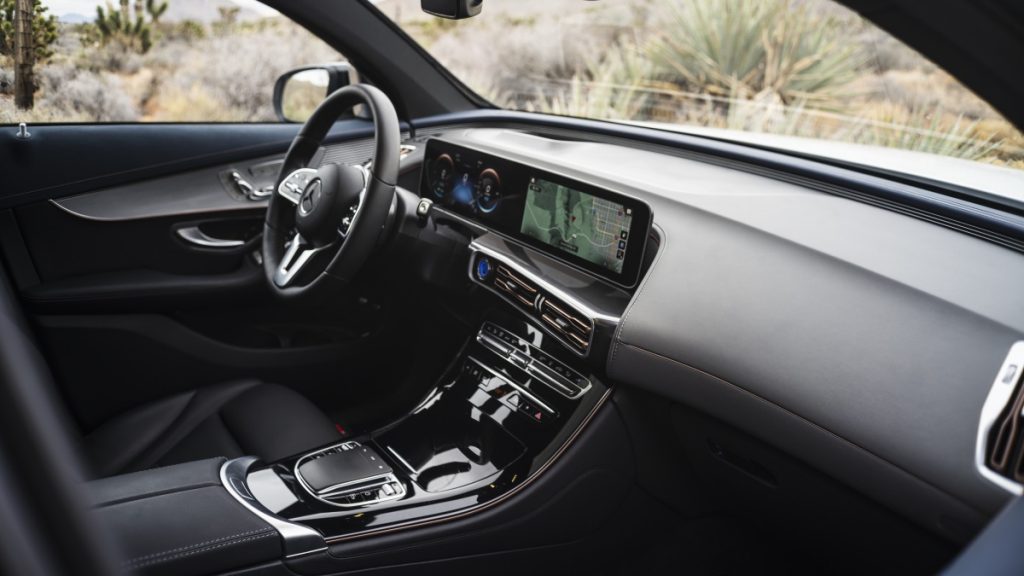The Mercedes-Benz EQC among electric vehicles the first from the EQ brand is celebrating its premiere. The EQC symbolises the beginning of a new mobility era at Daimler.
With its seamless, clear design and color highlights typical of the brand, it is a pioneer for an avant-garde electric look while representing the design idiom of Progressive Luxury. With respect to quality, safety and comfort the EQC

As the first Mercedes-Benz model under the new product and technology brand EQ, the Mercedes-Benz EQC has many trailblazing design details and

A striking feature at the front is the large black-panel surface enclosing the headlamps and grille. Exclusively for the American market the large Mercedes star on the panel is illuminated at night as standard and for the first time it can also be combined with the radar-controlled DISTRONIC. This ensures a particularly impressive look in darkness. The Night Design is also unique thanks to the inclusion of the fibre-optic cable for the first time. As the finishing touch to the top of the Black Panel it provides a visual link to the characteristic Mercedes‑Benz daytime running lights. This creates an almost uninterrupted, horizontal light band. The inner housings and tubes of the standard MULTIBEAM LED headlamps are in high-gloss black. Contrasting colour highlights discreetly confirm the model’s membership of the new EQ family: blue stripes on a white background, and MULTIBEAM lettering also in blue.

The high-quality interior of the EQC also pioneers an avant-garde electro-look. One example is the

To reduce power consumption and increase dynamism, the electric drivetrains are configured differently: the front electric motor is optimized for best possible efficiency in the low to medium load range, while the rear one determines dynamism. Together, they generate an output of approx. 300 kW and a combined maximum torque of 765 Nm. Mercedes-Benz engineers have enhanced noise comfort with a number of measures. In the EQC the power packs are isolated by rubber mounts at two points: where the powerpack connects to its subframe and where the subframe connects to the body. This effective isolation is supplemented with insulation measures. As a result, the interior of the EQC is extremely quiet.

The lithium-ion battery, which has an energy content of 80 kWh (NEDC), supplies the vehicle with power. The power consumption and range of electric vehicles greatly depend on the driving style. The EQC supports its driver with five driving programs, each with different characteristics: COMFORT, ECO, MAX RANGE, SPORT and an individually adaptable program. In the more economical driving modes, the haptic accelerator pedal that prompts the driver to conserve power plays an important role. The driver is also able to influence the recuperation level using so-called paddles behind the steering wheel. The ECO Assist system gives the driver comprehensive support when driving predictively: by prompting the driver when it is appropriate to come off the accelerator, e.g. because the vehicle is approaching a speed limit, and by functions such as coasting and specific control of recuperation. For this purpose, navigation data, traffic sign recognition and information from the intelligent safety assistants (radar and stereo camera) are linked and processed.

As standard the EQC is equipped with a water-cooled onboard charger (OBC) with a capacity of 7.4 kW, making it suitable for AC charging at home or at public charging stations. Within the EU the charging process at a Mercedes-Benz Wallbox is up to three times faster than at a household socket; in the USA the time advantage when charging at a Wallbox is even up to eight times as much, because here the voltage at a household socket is usually 120 V. It is faster still with DC charging – which is standard for the EQC, with a suitable market-specific plug – for example via CCS (Combined Charging Systems) in Europe and the USA, CHAdeMO in Japan or GB/T in China. Depending on the SoC (status of charge), the EQC can be charged with a maximum output of up to 110 kW at an appropriate charging station. It then takes around 40 minutes to charge from 10 to 80 percent SoC (provisional figures).

The EQC features the innovative multimedia system

By

A special feature of Interior Assist is the personal favourites function. The driver and front passenger can both program a personal, favourite function which is initiated using a horizontally outstretched index and middle finger. In this way, any command which is controllable via MBUX can be stored for simple access. One typical favourite command is “navigate me home”. The system is also in a position to detect reliably whether it is being operated by the driver or front passenger. This even means that they can each assign their own different favourites with the same hand position. There are other functions which can be controlled intuitively, without any need to practise corresponding gestures: In the dark, the reading lamp can be switched on and off by briefly extending a hand towards the rear-view mirror, for example. If the driver reaches over towards the (unoccupied) front passenger seat in the dark, it will be illuminated automatically. This makes it easier to find any items which may have been deposited on the seat. As soon as the person’s hand leaves this area, the light automatically switches off again.

EQ with Mercedes
The EQC is equipped with the latest generation of Mercedes-Benz driving assistance systems. In the Driving Assistance package, these include new functions such as predictive speed adjustment when approaching the end of a tailback: when a tailback is detected, Active Distance Assist DISTRONIC reduces the speed to around 100 km/h as a precaution. In a tailback on the motorway, the lane guidance system keeps the vehicle off-centre to leave space for the emergency services. The EQC also meets the highest requirements with respect to passive safety: in addition to the usual, extensive programme of crash tests, Mercedes-Benz applies further, particularly stringent safety standards to the battery and all component parts carrying electrical current. These standards exceed legal requirements. The vehicle structure of the EQC has been adapted to suit the special requirements of the electrical components and battery, and is configured to achieve the usual high safety level. For example, a new subframe surrounds the drive components located in the front section, and this unit is supported by the usual mounting points.
Mechanical protection of the battery: the high-safety design begins with the installation position of the high-voltage battery beneath the vehicle floor. The energy storage unit is surrounded by a stable frame that can absorb energy. Deformation elements are installed between the frame and the battery, and these are able to absorb additional forces in the event of a severe side impact. A battery guard in the front area of the battery is able to prevent the energy storage unit from being pierced by foreign objects. Electrical protection of the high-voltage system: the extensive experience of Mercedes-Benz with high-voltage drive systems has led to a multi-stage safety concept that deploys in the event of an accident. The high-voltage system automatically shuts down, reversibly or irreversibly, according to the severity of the accident. There are also shutdown points where emergency teams can deactivate the high-voltage system manually.
By market launch, 200 prototypes and pre-production vehicles of the EQC will have absolved tests covering several million kilometres across four continents (Europe, North America, Asia and Africa). The test program comprises more than 500 individual tests. Like all Mercedes-Benz vehicles, the EQC must absolve the demanding standard test programme. There are also special tests for the electric powertrain, the fuel cell, and the interplay of all powertrain components. In the process the test experts are able to build upon the extensive findings from their digital testing work, used to ensure both the buildability of the vehicle and for the simulation of e.g. crash behavior, aerodynamics

